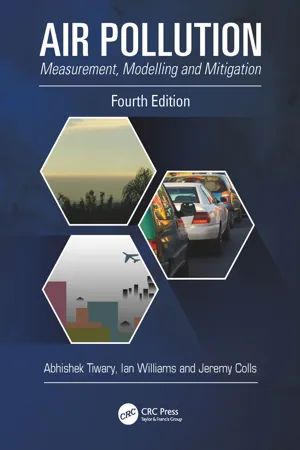
Air Pollution
Measurement, Modelling and Mitigation, Fourth Edition
- 696 pages
- English
- ePUB (mobile friendly)
- Available on iOS & Android
About this book
This established textbook offers a one-stop, comprehensive coverage of air pollution, all in an easy-reading and accessible style. The fourth edition, broadly updated and developed throughout, includes a brand-new chapter providing a broader overview to the topic for general reading, and presents fresh materials on air pollution modelling, mitigation and control, tailored to the needs of both amateur and specialist users. Retaining a quantitative perspective, the covered topics include: gaseous and particulate air pollutants, measurement techniques, meteorology and modelling, area sources, mobile sources, indoor air, effects on plants, materials, humans and animals, impact on climate change and ozone profiles and air quality legislations. This edition also includes a final chapter covering a suite of sampling and laboratory practical experiments that can be used for either classroom teachings, or as part of research projects. As with previous editions, the book is aimed to serve as a useful reading resource for upper-level undergraduate and postgraduate courses specialising in air pollution, with dedicated case studies at the end of each chapter, as well as a list of revision questions provided at the end as a complementary section.
Frequently asked questions
- Essential is ideal for learners and professionals who enjoy exploring a wide range of subjects. Access the Essential Library with 800,000+ trusted titles and best-sellers across business, personal growth, and the humanities. Includes unlimited reading time and Standard Read Aloud voice.
- Complete: Perfect for advanced learners and researchers needing full, unrestricted access. Unlock 1.4M+ books across hundreds of subjects, including academic and specialized titles. The Complete Plan also includes advanced features like Premium Read Aloud and Research Assistant.
Please note we cannot support devices running on iOS 13 and Android 7 or earlier. Learn more about using the app.
Information
Air pollutants | Directive |
PM – PM10, PM2.5, NOx, O3, SO2, PAHs, Benzene, 1,3-butadiene, CO, Pb | Air Quality Strategy |
SO2, NH3, NOx, NMVOC | National Emissions Ceilings Directive (NECD) |
SO2, NH3, NOx, NMVOC, Heavy Metals, POPs | Convention on Long-Range Transboundary Air Pollutants (CLRTAP) |
91 compounds including: CH4, CO, CO2 HFCs, N2O, SF6, NH3, NMVOC, NOx, PFCs, SOx, CFCs, As, Cd, Cr, Cu, Hg, Ni, Pb, Zn, PM10, Benzene, HCl, HF, PAHs, PCBs, PCDD, PCDF, Gamma HCH, PCP, HCB | European Pollutant Release and Transfer Register (E-PRTR), which succeeds the European Pollutant Emission Register (EPER) |
SO2, NOx, CO, VOCs, metals, dust, asbestos, chlorine and its compounds | Integrated Pollution Prevention and Control (IPPC) |
SOx, NOx, PM | Large Combustion Plants Directive (LCPD) |
Dust (PM), HCl, HF, SO2, NOx, Heavy metals, Dioxins and Furans, CO | Waste Incineration Directive (WID) |
VOCs | Solvent Emissions Directive |
VOC | Paints Directive |
SO2 | The Sulphur Contents of Liquid Fuels Directive |
VOC | Petrol vapour recovery |
SO2, NOx, PM, Lead, Benzene, CO, Ozone, PAH, Cadmium, Arsenic, Nickel, Mercury | EU Air Quality Directives |

Table of contents
- Cover
- Half Title
- Title Page
- Copyright Page
- Table of Contents
- Preface
- Authors
- 1 Overview of air pollution
- 2 Gaseous air pollutants
- 3 Particulate matter
- 4 Area sources
- 5 Mobile sources
- 6 Ambient air quality
- 7 Indoor air quality
- 8 Air pollution modelling
- 9 Air pollution control and mitigation
- 10 Air pollution impacts
- 11 Air pollution and climate change
- 12 Air pollution impacts on ozone
- 13 Noise and light pollution
- 14 Air quality standards and legislations
- 15 Air quality experiments
- Review questions
- Index